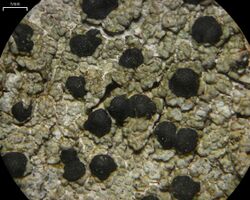Biology:Mycoblastus
| Mycoblastus | |
|---|---|

| |
| Closeup of the lichen Mycoblastus sanguinarioides; scale bar is 1 mm | |
| Scientific classification | |
| Domain: | Eukaryota |
| Kingdom: | Fungi |
| Division: | Ascomycota |
| Class: | Lecanoromycetes |
| Order: | Lecanorales |
| Family: | Tephromelataceae |
| Genus: | Mycoblastus Norman (1852) |
| Type species | |
| Mycoblastus sanguinarius (L.) Norman (1926)
| |
| Synonyms[1] | |
| |
Mycoblastus is a genus of crustose lichens in the family Tephromelataceae.[2] Members of the genus are commonly called blood lichens.[3][4]
Taxonomy
The genus was circumscribed in 1852 by Johannes Musaeus Norman, who selected the widespread Mycoblastus sanguinarius as the type species.[5] This species was one of many introduced by Carl Linnaeus in his influential 1753 work Species Plantarum, as Lichen sanguinarius.[6] In North America this species is colloquially known as the "bloody-heart lichen".[7]
In 1984 Josef Hafellner created the family Mycoblastaceae to contain this genus, but this family has since been placed in synonymy with the Tephromelataceae.[8]
Description
Mycoblastus species produce a grayish-white or greenish-gray crustose thallus that contains a green algal photobiont from the genus Trebouxia. The apothecia are typically large, hemmispherical, shiny black or dark pigmented, and lack a margin. There are highly branched and anastomosing paraphyses that form a network around the asci. The asci are lecanoralean (meaning an apothecium containing algae at least below the hypothecium and usually having a distinct amphithecium that often also contains algae) that mostly contain one or two, colorless, thick-walled ascospores.[7]
Species
As of April 2021, Species Fungorum accepts 14 species of Mycoblastus:[9]
- Mycoblastus affinis (Schaer.) T.Schauer (1964) – temperate Northern Hemisphere
- Mycoblastus alpinus (Fr.) Th.Fr. ex Hellb. (1885) – temperate Northern Hemisphere
- Mycoblastus bryophilus Imshaug ex Kantvilas (2009)[10] – Campbell Island; Tasmania
- Mycoblastus caesius (Coppins & P.James) Tønsberg (1992) – temperate oceanic areas of the Northern Hemisphere
- Mycoblastus campbellianus (Nyl.) Zahlbr. (1926) – New Zealand; Tasmania; Campbell Island; Macquarie Island; Australia; Tierra del Fuego; Chile
- Mycoblastus coniophorus (Elix & A.W.Archer) Kantvilas & Elix (2009)[10] – Chile; Juan Fernandez; Auckland Island; Macquarie Island; Prince Edward Island; Tasmania; Australia
- Mycoblastus disporus (C.Knight) Kantvilas (2009)[10] – Tasmania; New Zealand
- Mycoblastus kalioruber Kantvilas (2009)[10] – Tasmania
- Mycoblastus leprarioides Kantvilas & Elix (2009)[10] – Australia
- Mycoblastus oreotropicanus Kantvilas (2016)[11] – Papua New Guinea
- Mycoblastus physodalicus Kantvilas (2016)[11] – Queensland, Australia
- Mycoblastus sanguinarioides Kantvilas (2009)[10] – Tasmania; Australia
- Mycoblastus sanguinarius (L.) Norman (1926) – temperate Northern Hemisphere
- Mycoblastus sinensis Kantvilas (2011)[12] – China
The species once known as Mycoblastus fucatus was transferred into a new genus, Violella, circumscribed in 2011 to contain it and other similar species with Biatora-type asci and unusual pigmentation in the hymenium.[13]
References
- ↑ "Synonymy: Mycoblastus Norman, Conat. Praem. Gen. Lich.: 25 (1852)". Species Fungorum. http://www.speciesfungorum.org/Names/SynSpecies.asp?RecordID=3310.
- ↑ Wijayawardene, Nalin; Hyde, Kevin; Al-Ani, Laith Khalil Tawfeeq; Somayeh, Dolatabadi; Stadler, Marc; Haelewaters, Danny et al. (2020). "Outline of Fungi and fungus-like taxa". Mycosphere 11: 1060–1456. doi:10.5943/mycosphere/11/1/8.
- ↑ "Name Search Results - USDA PLANTS". http://plants.usda.gov/java/nameSearch. Retrieved 28 February 2017.
- ↑ "Blood Lichen - Mycoblastus - Overview - Encyclopedia of Life". http://eol.org/pages/22488/overview. Retrieved 28 February 2017.
- ↑ Norman, J.M. (1853). "Conatus praemissus redactionis novae generum nonullorum lichenum" (in la). NYT Magazin for Naturvidenskaberne 7: 213–252. https://www.biodiversitylibrary.org/page/8152367.
- ↑ Linnaeus, Carl (1753) (in la). Species Plantarum. 2. Stockholm: Impensis Laurentii Salvii. p. 1140. https://www.biodiversitylibrary.org/page/359161.
- ↑ 7.0 7.1 Brodo, Irwin M.; Sharnoff, Sylvia Duran; Sharnoff, Stephen (2001). Lichens of North America. Yale University Press. p. 446. ISBN 978-0300082494.
- ↑ Kraichak, Ekaphan; Crespo, Ana; Divakar, Pradeep K.; Leavitt, Steven D.; Lumbsch, H. Thorsten (2017). "A temporal banding approach for consistent taxonomic ranking above the species level". Scientific Reports 7 (1): 2297. doi:10.1038/s41598-017-02477-7. PMID 28536470. Bibcode: 2017NatSR...7.2297K.
- ↑ Source dataset. Species Fungorum Plus: Species Fungorum for CoL+. "Mycoblastus". Catalog of Life Version 2021-04-05. https://www.catalogueoflife.org/data/taxon/5W3X.
- ↑ 10.0 10.1 10.2 10.3 10.4 10.5 Kantvilas, Gintaras (2009). "The genus Mycoblastus in the cool temperate Southern Hemisphere, with special reference to Tasmania". The Lichenologist 41 (2): 151–178. doi:10.1017/S0024282909008238. https://www.researchgate.net/publication/231977880.
- ↑ 11.0 11.1 Kantvilas, Gintaras (2016). "Observations on some tropical species of the lichen genus Mycoblastus Norman (Mycoblastaceae)". Austrobaileya 9 (4): 539–545. doi:10.5962/p.299881. https://www.qld.gov.au/__data/assets/pdf_file/0030/69087/kantvilas-tropical-mycoblastus-austobaileya-v9s4-p539-545.pdf.
- ↑ Kantvilas, Gintaras (2011). "Mycoblastus sinensis, a new lichen species from China". Journal of Japanese Botany 86: 59–62. http://www.jjbotany.com/pdf/JJB_086_059_062.pdf.
- ↑ Spribille, Toby; Goffinet, Bernard; Barbara, Klug; Muggia, Lucia; Obermayer, Walter; Mayrhofer, Helmut (2011). "Molecular support for the recognition of the Mycoblastus fucatus group as the new genus Violella (Tephromelataceae, Lecanorales)". The Lichenologist 43 (5): 445–466. doi:10.1017/S0024282911000478. PMID 22936837.
Wikidata ☰ Q10591072 entry
 |

